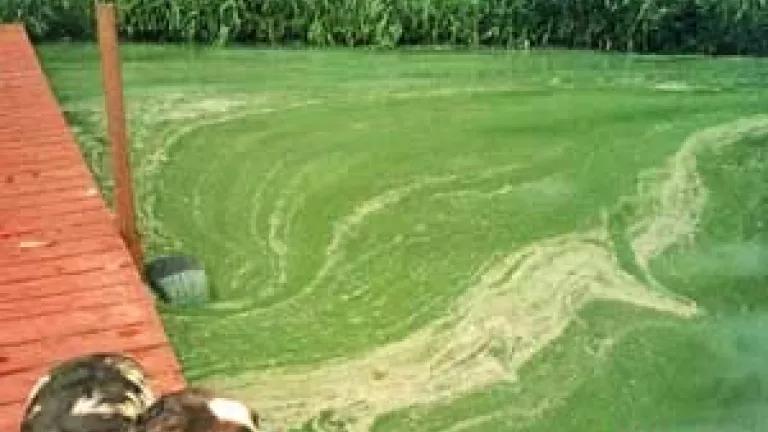
You would think that the EPA would be eager to seize hold of opportunities to deal with a massive pollution debacle it characterizes as “one of America’s most widespread, costly, and challenging environmental problems.” We’d hoped so too. That’s why a number of environmental groups, primarily ones based in the Mississippi River basin, submitted two petitions to EPA laying out a proposed path forward for checking the spread of toxic green mats of algae that are choking our nation’s waterways and creating a dead zone in the Gulf of Mexico bigger than some states.
Sadly, EPA’s response to the petitions has only served to highlight its paralysis in the face of this challenge. Following on its denial last year of the first petition, which NRDC has sued over, EPA two weeks ago denied the second petition as well.
While the first petition called on EPA to use its standard-setting authority to limit the concentration of algae-fueling pollutants – nitrogen and phosphorus – in lakes, rivers, and streams, the second petition called on it to limit discharge of those pollutants by one of their major sources: sewage treatment plants. The petition pointed out that the Clean Water Act requires EPA “from time to time” to take a look at what kind of pollution removal can be achieved by secondary treatment, meaning the biological systems that treatment plants use to clean up sewage before discharging it back into waterways. Last time EPA did that was in 1985. Although the Act doesn’t define exactly what “from time to time” means, we’re pretty sure it means something other than once every 30 or so years. Particularly since, in the intervening time, the technology has evolved to the point where it can be used to pretty effectively remove significant amounts of nitrogen and phosphorus from the treated sewage.
In its response, EPA claimed it lacked sufficient information to say what kind of nitrogen and phosphorus removal secondary treatment can achieve – even though NRDC had provided it in the petition with extensive technical information regarding the capability of the technology, and invited EPA if it disagreed to perform its own analysis on this pretty important subject. What was really ironic, though, was the Agency’s blithe assertion that a better way to deal with the problem would be through permits for individual sewage plants, linked to water quality standards for their particular receiving waters – when it had just finished refusing to set water quality standards in response to our other petition.

This head-in-the-sand response is merely the latest chapter, unfortunately, in the history of EPA’s epic-scale dithering over the nation’s growing algae problem. The Agency has known about the huge and growing Gulf “dead zone,” the result of decomposing algae sucking oxygen out of the Gulf waters, since the 1980s. EPA even said in 1998 that if states did not immediately act to establish standards for nitrogen and phosphorus, it would take charge and do so itself – but never followed through. And not long after that Lake Erie began to turn green again with the reappearance of slimy, malodorous mats of algae. (The poor condition of Lake Erie was actually referenced in the original 1971 version of Dr. Seuss’s iconic story of the doomed humming fish, but removed when the lake’s condition improved.) The problem now threatens Lake Michigan and countless other water bodies throughout the nation, annually ruining recreation, driving up drinking water treatment costs, and in some cases killing pets and threatening human health with its toxic by-products. EPA, although frequently acknowledging the problem, for all those years has done little more than paint a caricature-quality portrait of bureaucratic paralysis, periodically emerging from hiding to issue yet another “urgent call” for more meetings, study, and collaboration.

EPA has been so paralyzed, in fact, that it didn’t even respond to our petitions for years. We sent the sewage pollution petition in 2007, and finally had to sue the agency this year in federal district court to get a response. The Agency didn’t respond to the water quality standards petition, sent in 2008, until we threatened a similar lawsuit.
It’s unfortunate that NRDC and our partners need to relentlessly pressure EPA to take basic steps to address an environmental problem that the Agency itself has identified as costly and massive. But that’s what we’ll continue to do as long as need be. Because it’s been pretty well established that dithering over algae is not going to make it go away.
Photos by Amy Goerwitz




